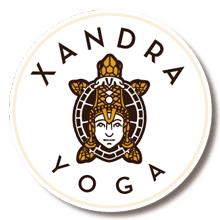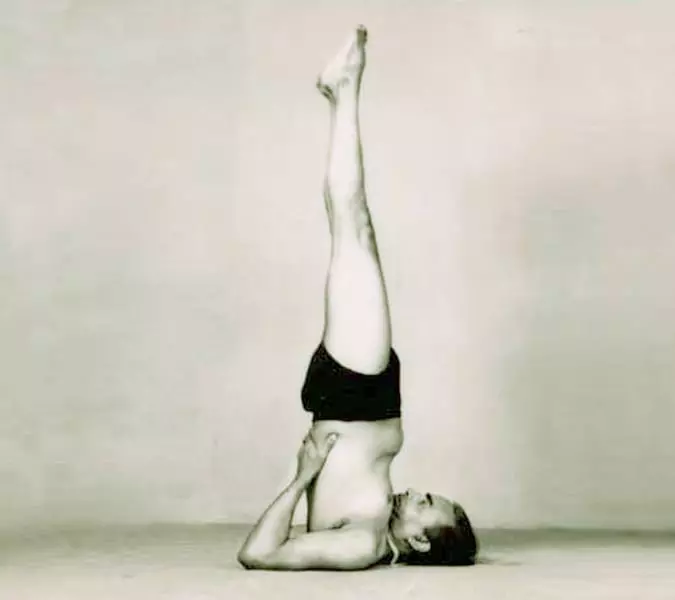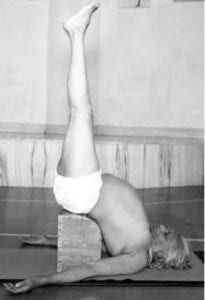Photo Credit: BKS Iyengar – Svastha Ayurveda
Also named as « Salamba Sarvangasana ».
Salamba – with support, Sarvanga – all limbs
Sarvangasana is part of the closing series during an Ashtanga Vinyasa yoga practice. However it can be also done during any Hatha Yoga class.
Sarvangasana is an inversion, calming asana.
From an energetic level it activates:
- Vishuda Chakra (throat)
- Ajna Chakra (3rd eye)
- Sahasrara Chakra (tof of the skull)
Sahasrara Chakra will be activated as well during Shirshasana.
Please note that even though we are « activating » those chakras, that does not mean that we are opening them. It takes more than asana practice to feel and manage chakras.
Regarding Bandha, Sarvangasana will be focused on Jalandara Bandha (the throat).
As a yoga teacher it is very important to understand the sequence to be taught.
All asanas practices should included inversions at the end of the class in order to prepare the body for deep pranayama practice, meditation and ultimately Samadhi.
Samadhi will not be reached after one class.
However it is always possible to reach it while eating chocolate ice cream (if you like chocolate) or anything else that brings you in a blissful time.
The simple fact of being happy is kind of Samadhi as well.
Sarvangasana – Where is the weight?
Sarvangasana is one of the posture poorly taught or poorly practiced. Sometimes it is hard to know if the problem comes from the teacher or from the student.
When practicing Sarvangasana, if you feel that the body weight is pressurising your cervicales, or your head, then it is a sign that the way it is done is not good.
If your student is telling you that he is encountering pain toward the neck region, same sign as well. In this case it is better to dismount and to rethink the asana.
The weight should be into the arms, biceps, shoulder blade on the mat, pushing against it, hands in the middle back lengthening the all structure toward the sky.
As a teacher if you see your student doing this:
- Please correct the elbows, they should be well aligned with the shoulders, slightly in, in contact with the floor,
- Bring the legs forward and not backard,
- Place the hands in the middle of the back and ask your student to lengthen the spine up toward the sky,
- You can also use a yoga belt between the arms, above the elbows,
- Do not let your student struggled in this asana, as it is clearly showing that the weight is on the cervical spine….
You should not lift up your students legs. Why? First of all the effect of surprise, and second thing the action might lift the head and shoulders as well.
However if you really like that kind of adjustment, be sure of where you have to stand.
Hold the legs from the ankles, and instead of lifting up, lengthen both legs at the same time, then ask your student to bring his/her elbows behind the back and the hands in the middle of the torso, fingers up, lengthening the skin and the spine up.
The upper body should be active at all time. Scapula are pushing against the floor in order to open the chest.
The upper body is the base of the structure.
As a yoga teacher, it is not easy being able to « read » the body in front of you. But it is highly essential to do so.
At first sight the teacher should be able to see what is going on.
Sometime people are teaching Sarvangasana with a blanket, « in order to protect the cervicales ». The blanket is then folded and placed below the cervicale spine.
If at all the teaching is like that, it means that the body weight will not be distributed correctly.
There is no need of blanket for Sarvangasana. Arms are holding the body.
Viparita Karani versus Sarvangasana
Some teacher give a « variation » to Sarvangasana which is Viparita Karani.
Viparita – Inverted, Reverse, Karani – Doing, Making
Viparita Karani is not the variation of Sarvangasana.
Viparita Karani is the first step in the practice of the 20th Kriyas of Kundalini Yoga.
If you have to give a variation to your student, bring them toward the wall, and ask them to bring their legs on the wall, upper body flat on the mat.
Conclusion
Yoga practice does not harm, there in no dangerous asana, there is no « Yoga pose that hurt cervical spine, or lower back or something else ».
However poorly taught yoga and poorly practiced yoga does exist.
More often the problem is between the yoga mat and the practitioner.
Also if the teacher is not practicing on a regular basis, it will become very difficult for him/her to convey the right information.
As well, if during a teaching class, the teacher is practicing while teaching, then he/she won’t be able to see his/her students and then in the incapacity of giving any good instructions, modification, neither adjustments.
Namaste !




